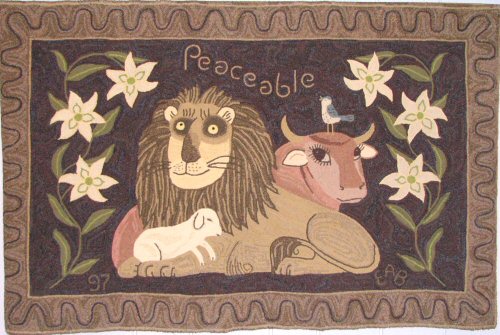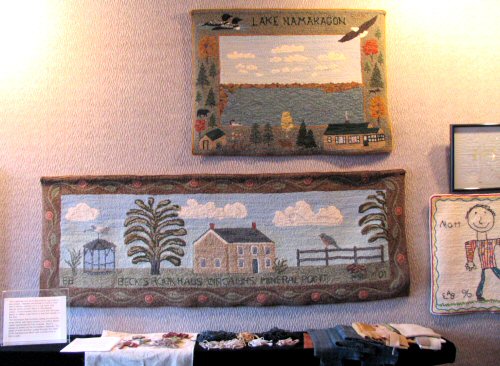When I was a child we frequently visited
the home of my parents' friends, Joe and Florence Schneider. After saying
hello, the next thing I did was run upstairs to the boys' rooms to see
if there were any new toys. While going up the stairs I enjoyed looking
at the "pictures" on the risers of the stair runner that Florence had hooked.
Each riser had a different self designed depiction of something from their
lives. I loved it.
 As a young adult I became a collector of antiques
and eventually also a dealer. Textiles were always a special love of mine
and so I became very familiar with samplers, fancy work, hooked rugs, hand
woven coverlets, etc. When supplies for doing counted thread cross
stitch became available in the area, I readily took on that hobby and for
about ten years I stitched designs from kits and books, and samplers of
my own design. I was interested in rug hooking but the problem was
that I was not able to find any sources of material or information in this
area. In the mid 1980s I finally treated myself to a rug hooking camp in
Maine. There, along with eight other women I learned the craft and
bought some simple supplies (hook, backing, wool cutter, appropriate scissors
and some packages of dye) and tried to continue at home. The hobby languished
until 1990 when I serendipitously met some rug hookers from the Madison
area who invited me to join their monthly meetings. One of them had attended
a new rug hooking camp in Vermont and so several of us went there in June
of 1991. That experience really motivated me.
As a young adult I became a collector of antiques
and eventually also a dealer. Textiles were always a special love of mine
and so I became very familiar with samplers, fancy work, hooked rugs, hand
woven coverlets, etc. When supplies for doing counted thread cross
stitch became available in the area, I readily took on that hobby and for
about ten years I stitched designs from kits and books, and samplers of
my own design. I was interested in rug hooking but the problem was
that I was not able to find any sources of material or information in this
area. In the mid 1980s I finally treated myself to a rug hooking camp in
Maine. There, along with eight other women I learned the craft and
bought some simple supplies (hook, backing, wool cutter, appropriate scissors
and some packages of dye) and tried to continue at home. The hobby languished
until 1990 when I serendipitously met some rug hookers from the Madison
area who invited me to join their monthly meetings. One of them had attended
a new rug hooking camp in Vermont and so several of us went there in June
of 1991. That experience really motivated me.
 I find the process of making a rug almost
more enjoyable than the finished product. I enjoy hooking my own designs
as much as commercial designs. My style is considered primitive because
of using the wider cuts (up to 5/8 inches wide) and more naive designs.
With primitive, there are no rules of perspective or realism. Animals can
be any color and flowers are often forms not found in nature. These fanciful
flowers are known to rug hookers as padulas. Shading is accomplished by
using different pieces of fabric rather than a subtly dyed piece. Textured
or patterned wool adds to the primitive look. The same design becomes
unique just using different colors and textures. In June, I will
return to the Green Mountain Rug Camp in Vermont for the 13th time. I have
begun the process of designing a pattern (a medieval town) and choosing
fabrics from a rather vast "collection" of recycled and new wool. Some
I will use ''as is" and others I will over dye. Color planning is said
by some to be the most important part of making a rug. Technique and pattern
are second to that. Sometimes reverse hooking is necessary. That's
the term we use for ripping out and re-hooking. Eventually, the rug
gets done but even before that, another rug to hook comes to mind.
I find the process of making a rug almost
more enjoyable than the finished product. I enjoy hooking my own designs
as much as commercial designs. My style is considered primitive because
of using the wider cuts (up to 5/8 inches wide) and more naive designs.
With primitive, there are no rules of perspective or realism. Animals can
be any color and flowers are often forms not found in nature. These fanciful
flowers are known to rug hookers as padulas. Shading is accomplished by
using different pieces of fabric rather than a subtly dyed piece. Textured
or patterned wool adds to the primitive look. The same design becomes
unique just using different colors and textures. In June, I will
return to the Green Mountain Rug Camp in Vermont for the 13th time. I have
begun the process of designing a pattern (a medieval town) and choosing
fabrics from a rather vast "collection" of recycled and new wool. Some
I will use ''as is" and others I will over dye. Color planning is said
by some to be the most important part of making a rug. Technique and pattern
are second to that. Sometimes reverse hooking is necessary. That's
the term we use for ripping out and re-hooking. Eventually, the rug
gets done but even before that, another rug to hook comes to mind. |

